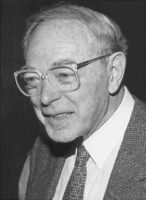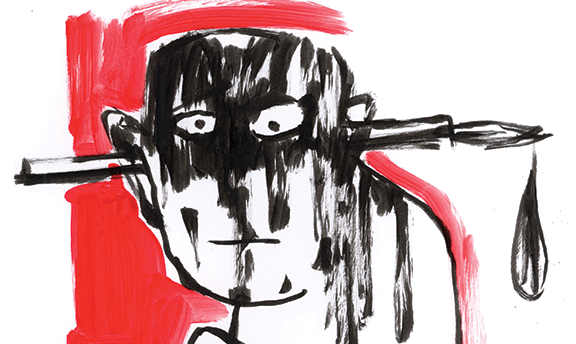
“As you honor Zellig Harris today, and celebrate the publication of this new collection of writings, pause a moment to think about what would be missing if Harris had never explored the world of linguistics,” said Provost Robert Barchi at the outset of a January symposium dedicated to the legacy of the late Dr. Zellig Harris G’32 Gr’34.
In addition to founding and chairing the nation’s first linguistics department at Penn in 1947, Harris “touched fields he never dreamed of influencing when he began his research,” Barchi added, including “every line of research related to the nature of language in psychology, computer science, mathematics, anthropology, and philosophy.” The Russian-born Harris, whose books included Methods in Structural Linguistics, Mathematical Structures of Language, Papers in Structural and Transformational Linguistics, and the posthumously published The Transformation of Capitalist Society, died in 1992.
The day-long symposium in Houston Hall featured more than a dozen scholars from a broad range of disciplines and several nations. (Harris’s most famous student, Dr. Noam Chomsky C’48 G’51 Gr’55 Hon’84, declined to take part in either the symposium or the book, but he has often acknowledged Harris’s influence [“Speech!” July/August 2001].) The event was organized by Dr. Bruce E. Nevin CGS’68 G’70 Gr’98, a former student of Harris’s and now a senior technical specialist with Cisco Systems, who edited a two-volume set of essays titled The Legacy of Zellig Harris: Language and Information into the 21st Century, published by John Benjamins.
Having taken it upon himself to help repair Harris’s linguistic reputation, which he sees as having been damaged by inaccurate accusations of behaviorism and anti-mentalism, Nevin wrote in the forward: “Harris recognized no standpoint outside of language from which one may describe language. Without an understanding of this fundamental fact, the methodological strictures that Harris imposed on his work are incomprehensible. Those who (without understanding this) have attempted to account for the incomprehensible have described Harris as anti-mentalist, positivist, even behaviorist—preposterous falsehoods, trivially refuted by simple examination of his writings. He did not even like the word ‘behavior.’”
“Someone once remarked that the trouble with Harris is that he was 30 years ahead of his time,” said Dr. Naomi Sager, research professor of computer science at NYU’s Courant Institute of Mathematical Sciences. “In computer science, you can add at least a decade to that.” During her talk, “From Text to Information by Computer,” she noted that as far back as 1959, a group led by Harris proved that “language structure is computable.”
Dr. Aravind Joshi GEE’58 GrE’60, the Henry Salvatori Professor of Computer and Cognitive Science and co-director of Penn’s Institute for Research in Cognitive Science, recalled how when he was a graduate student in electrical engineering in the late 1950s, he approached Harris about sitting in on a graduate course in linguistics: “I apologized for not having any linguistics background, to which he replied, ‘That’s actually good.’”
In many of his writings, Harris “pursued the strategy of eschewing as much hierarchical structure as possible in describing sentence structure,” noted Joshi, who was involved in researching the use of “cascaded finite state transducers [FSTs] for sentence analysis” as well as “string grammars,” both of which were part of the Transformations and Discourse Analysis Project (TDAP) that Harris directed from 1959 until about 1973. (That project built on another Harris-led parsing program, known as Uniparse, which made use of the old UNIVAC computer—successor to the ENIAC—and according to Joshi “was the first application of FSTs to parsing.”) The Uniparse program helped Joshi develop another program for transformational analysis (kernels and transformations), and it served as a precursor of the string-grammar program developed by Sager.
In 1973 Joshi began studying “tree-adjoining grammars” (TAGs), a “formal tree-rewriting system” that was another area of Harris’s research. And he has been studying them ever since. The whole framework of TAGs, he wrote in his essay, “allows us to cast the issue of minimal hierarchical structure necessary for sentence description in terms of the issue of minimal structure necessary for the elementary structure of the tree-adjoining grammars.”
Dr. Lila Gleitman G’72 Gr’75, professor of linguistics and the Steven and Marcia Roth Professor of Psychology at Penn, first studied under Harris more than four decades ago. Back then she was involved in the TDAP research (along with Joshi, Sager, and Dr. Carol Chomsky CW’51), and she acknowledged that Harris “would have been a little surprised, and even maybe a little dismayed, at the title of my talk”—which was “Language Learning Without Maturation.”
And yet, she noted in her essay, “such (roughly) bottom-up analyses of the speech stream as Harris’s seem to describe the first two years of infant life in remarkably close detail.”
“Having passed the critical period for acquiring 30 or 40 ancient Indo-European dialects when I entered the field of linguistics, I rapidly fell under the influence of Harris, whose thinking has guided me the rest of my intellectual life,” Gleitman wrote in the anthology, adding that Harris’s approach to language became “the sure and self-evident basis of my own thinking” so much as to “feel like my own quite clever inventions: that is, to lead to the well-known academic malady called Graduate Student Amnesia.”
“Harris’s work did not start with a big question and search directly for the answer,” wrote Naomi Sager and Dr. Ngo Thanh Nhàn in their essay on “The Computability of Strings, Transformations, and Sublanguage.” “His commitment to methods was such that it would be fair to say that the methods were the leader and he the follower. His genius was to see at various crucial points where the methods were leading and to do the analytic work that was necessary to bring them to a new result.”




